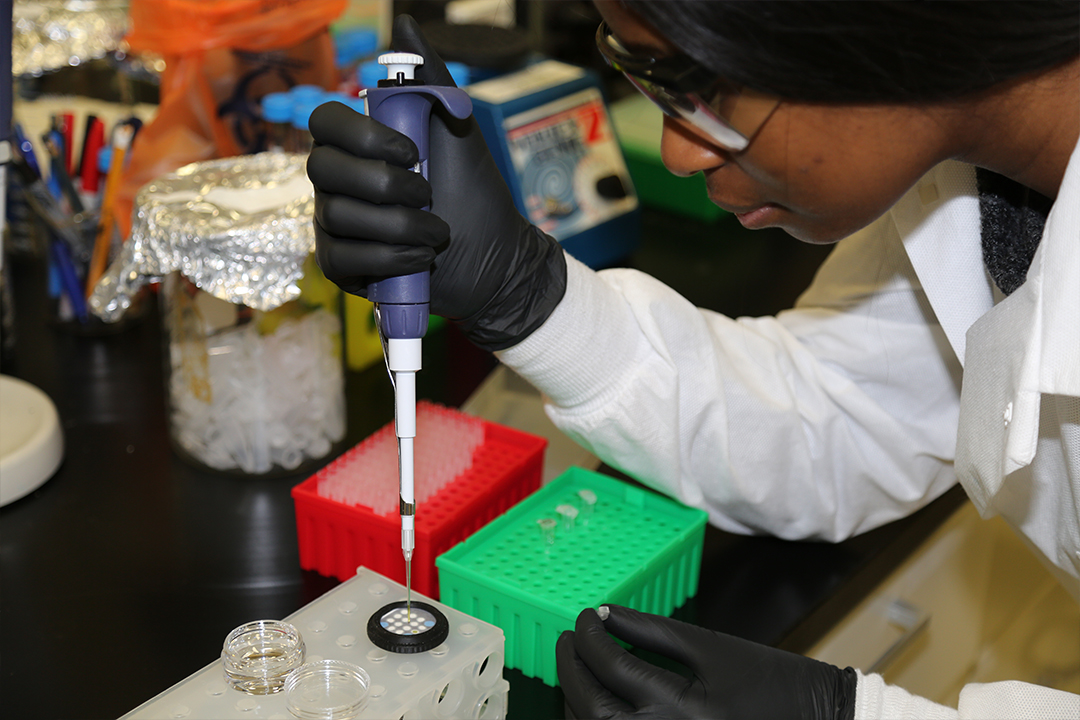// NEWS RELEASE
ECBC Joins Forces with Army, Navy and Air Force Research Laboratories to Develop a Paper-Based Field Sensor
CCDC Chemical Biological Center Public Affairs | April 12th, 2018
ECBC Joins Forces with Army, Navy and Air Force Research Laboratories to Develop a Paper-Based Field Sensor
DEVCOM CBC Public AffairsApril 12th, 2018

An ECBC scientist places a solution of protein complexes removed from a cell plus engineered DNA onto filter paper to get a colorimetric reaction that identifies the presence of a compound of interest.
In a three-year, $15-million-a-year research project funded by the Office of the Secretary of Defense (OSD), the Army Research Laboratory, Navy Research Laboratory, and Air Force Research Laboratory have teamed up with the Edgewood Chemical Biological Center (ECBC) to use synthetic biology to create an entirely new kind of field sensor.
“Essentially we are taking the guts out of a cell, adding a strand of engineered DNA which tells those guts what to do, and placing the combination as a drop on a piece of filter paper,” said Matthew Lux, Ph.D., who leads the ECBC team.
The “guts” Lux refers to are the protein complexes known as ribosomes and polymerases. Inside the cell they assemble molecules. In this application, they are instructed by the DNA to create ‘reporter’ molecules that change color in the presence of a compound of interest. That compound could be any type of chemical or biological agent.
In the field, a Soldier with no training will be able to simply place a drop of liquid sample on it and wait for a color change to occur. The liquid re-hydrates the freeze-dried solution and begins the reaction. The color change takes between 10 and 60 minutes, which makes it a good technology for sensing biological agents, but at this point, not fast enough to use for sensing fast-acting nerve agents such as sarin or VX.
For now, the interservice team is using this technique to identify explosives and for markers of substances in blood caused by stress or fatigue. The latter is of interest to the Air Force because they want to be able to monitor the hormones in pilots’ blood to optimize their performance. Ultimately, the Air Force would like to be able to modify the micro-biome ecosystems inside pilots’ bodies so that the bacteria, fungi, protozoa and viruses that live inside the human body are designed to promote good health.
While the Air Force is taking the lead in performance indicator sensing, the ECBC team is hard at work improving the paper and optimizing the colors produced by the reporter molecules. They plan to have a field-ready set of prototypes developed by the end of the contract. Meanwhile, the Navy team will stay busy researching alternatives to paper.
Although each service team has its own research niche, there is a great deal of communication and cooperation between them. The scientists from each service regularly visit each other’s laboratories, compare techniques and results, and they all use the same data repository. Ultimately, they will cooperate in publishing their research in scientific journals.
While the contract is only in its first year, OSD has a long-term goal beyond these three-years. OSD leadership has come to recognize the potential for synthetic biology to revolutionize everything from sensor technology to medicine to the development of advanced materials. They hope to build a knowledge and equipment infrastructure that cuts across the services to keep the U.S. military ahead of its adversaries in all these areas.
The U.S. Army Combat Capabilities Development Command (DEVCOM) leads in the discovery, development and delivery of technology-based capabilities to enable Soldiers to win our nation’s wars and come home safely. DEVCOM is a major subordinate command of the U.S. Army Futures Command. The DEVCOM Chemical Biological Center is the Army’s principal research and development center for chemical and biological defense technology, engineering and field operations. The DEVCOM Chemical Biological Center is headquartered at Aberdeen Proving Ground, Maryland.
